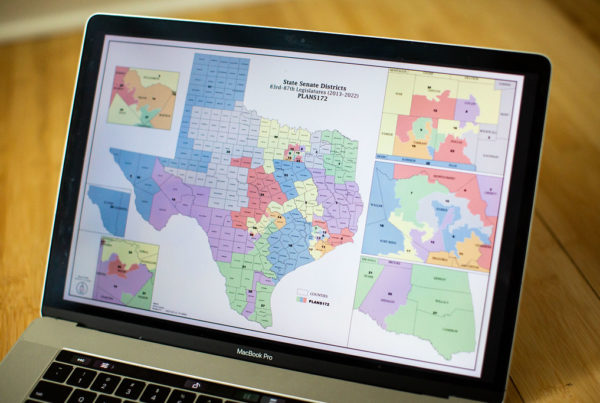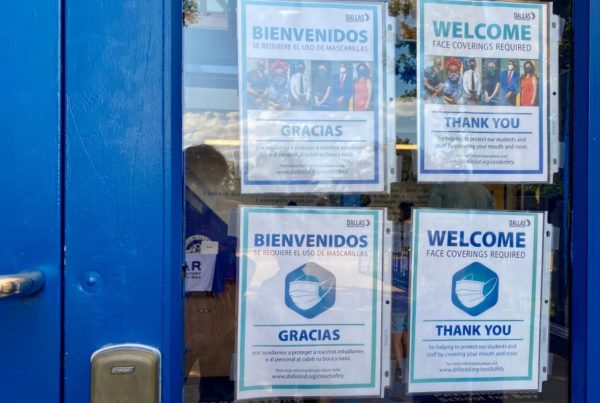Houstonians have hundreds of choices when signing up for an electricity plan. There are around 40 different retail electricity providers offering plans based on things like budget, family size, and increasing in popularity, plans backed by renewable energy.
However, even if you’re signed up for a renewable energy plan, your home is nonetheless powered by a mix of gas, coal, nuclear, wind and solar energy.
“We can’t separate electrons into buckets and deliver specific electrons to somebody’s house,” said Rebecca Bridges, Chief Marketing Officer for ElectricityPlans.com.
Bridges described the Texas electricity grid like a pot of soup: power plants – whether they’re wind or solar farms, or natural gas plants – generate the ingredients, in this case electricity. Power plants pour their electrons into the grid, like one might stir ingredients into a simmering soup. Once the electrons are on the grid, they’re part of the soup that’s delivered to homes.
“In 2021, [Texas grid manager] ERCOT’s projection was almost 29% of power coming from wind and 6% of power coming from solar,” Bridges said.
What makes renewable energy plans special is something called a Renewable Energy Credit, or Renewable Energy Certificate, often referred to as RECs in the electricity businesses.
“It’s an accounting mechanism,” said Mike Hoke,director of government relations for the Public Utility Commission. “When a customer buys a renewable plan, their retail electric provider goes out and purchases RECs, and the actual purchasing and trading of those takes place at ERCOT.”
ERCOT acts as the trading floor for these Renewable Energy Credits, Hoke said. A renewable energy power plant, like a wind or solar farm, generates one REC for each megawatt of green electricity it adds to the Texas grid. Those RECs are then bought by retail electricity providers and others.
For an electricity provider to ensure that your plan is backed by renewable energy, the provider buys RECs equal to the amount of power used, and then must essentially take that REC out of circulation. The company can’t re-sell or trade the credit any more.
“The intent of the program is to make sure that there’s not double counting of the same electron,” Hoke said. “When somebody purchases a renewable energy credit, that’s accounted for, and then somebody else can’t go out and purchase that same renewable energy credit. That’s the reason that you have this tracking of the buyers and sellers.”
Grid manager ERCOT tracks these RECs and submits an annual report to the state on the Renewable Energy Credit Trading Program, which includes lists of power plants authorized to sell RECs, as well as approved purchasers. ERCOT — the Electric Reliability Council of Texas — is overseen by the legislature as well as the Public Utility Commission, whose members are appointed by the governor.
“Right now, the renewable portfolio standard set by the legislature sets a goal that the state will have 10,000 megawatts of renewable generation by 2025,” Hoke said. “Right now we’ve got in the program about 40,000 megawatts – so we well exceeded that goal that the legislature set.”
It likely won’t surprise Texans that the state has emerged as the nation’s leader in wind energy. Last year Texas produced about 28% of the country’s wind-powered electricity, according to the U.S. Energy Information Association.
Overall Texas generates more electricity than any other state by far, nearly doubling the amount produced by its closest competitor, Florida.
Experts say that although purchasing a renewable energy electricity plan doesn’t mean your home is actually powered only with wind or solar, it does help support even more development of renewable energy generation in Texas.
It’s basic supply and demand – customers demand more renewable plans from their retailers, retailers then demand more renewables from generators, and to better meet demand power generators build more “green” energy into their systems, said Kosta Zujic with the retail electricity company Rhythm
“In essence, what you’re doing is you’re supporting that particular [renewable power] generator because you’re paying them for these renewable energy certificates,” Zujic said, “which incentivize them then to build more generation, more clean generation, which ultimately would serve us well in keeping our state clean.”
Zujic’s company Rhythm entered the Houston market earlier this year, with a goal of offering affordable renewable energy plans. For every megawatt hour of power created by a renewable generator, the company purchases a renewable energy certificate and matches the energy use of its customers to those certificates, Zujic said.
Rhythm customers have the option of supporting a specific renewable generator in Texas, the Chapman Ranch Wind Farm near Corpus Christi.
“If you drive around the area and you see it,” Zujic said, “it’s really cool to understand that, ‘wow, all these turbines have something to do with the way my home is being powered.'”
Renewable energy plans are becoming more and more popular in Houston, according to Rebecca Bridges of ElectricityPlans.Com.
“There are a lot of options out there,” she said, “a lot of smaller players who are making renewable energy more affordable than ever.”
However, Bridges added that consolidation in the electricity industry could limit choices and ultimately hurt competition and prices.
When Texas lawmakers deregulated the market nearly two decades ago it separated it into three groups: generation, like wind, solar, or natural gas plants; transmission, which include companies like CenterPoint that maintain infrastructure; and retail electricity providers, like Rhythm.
“What we have seen in probably the last four or five years is more of a consolidation,” Bridges said. “Now there are many more retailers that are owned by companies that also own generation. So the big example, of course, in the Houston area is Reliant, who is owned by NRG Energy.”
Renewable electricity provider Green Mountain is also owned by NRG. The February freeze exacerbated the issue as some smaller retailers were caught off guard by soaring wholesale prices and basically went out of business, or were bought out by bigger companies, Bridges said.
Still, Bridges said that overall choosing a renewable energy plan will support more wind and solar in the state – in essence, it’s like voting with your electricity bill.
“The more the people put their dollars toward renewable energy,” Bridges said, “that really sends a signal to the market that says we want more renewable energy in Texas.”















